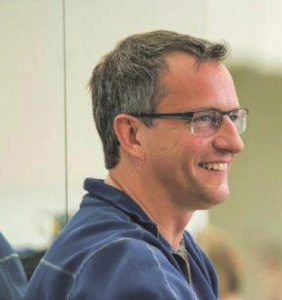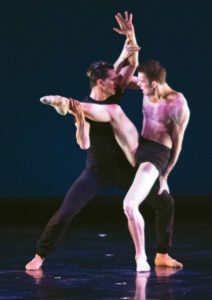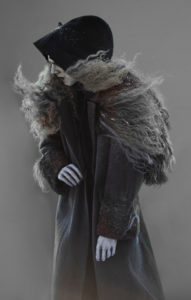A Mythic Tale for our Technological Age: Alberta Ballet and Jean Grand-Maître’s Frankenstein - Vancouver Ballet Society
- Home
- Features 2015 - 2019
- A Mythic Tale for our Technological Age: Alberta Ballet and Jean Grand-Maître’s Frankenstein

by Kaija Pepper
Mary Shelley’s Frankenstein has attained mythic status since it was published in 1818. We all know some version of this dark story about a scientist who creates life from the body parts of corpses, and the horror that results when he abandons his physically repulsive creation. Left to cope alone with the mystery of existence, the creature despairs and seeks revenge on his maker.
Victor Frankenstein, the scientist, has become synonymous with his creation who, unnamed in the novel, is today typically known as Frankenstein. When choreographer Jean Grand-Maître began to research his version of the tale for Alberta Ballet, the company he directs, this conflation of man and monster struck him as apt. The intelligent, highly civilized scientist is, after all, ultimately responsible for the destruction wreaked by his imperfect creation. “Victor played with the unnatural,” says Grand-Maître, “and there is darkness in his heart.”
As for the creature, it is his complete rejection by others that turns him into a monster. “The success in creating this role will be to capture the human trapped in the monster,” says Grand-Maître.

Photo: Courtesy of Alberta Ballet
We first spoke over the phone during the early stages of the Frankenstein creative process. At the time, Grand-Maître — known for his sextet of pop music ballets set to Joni Mitchell, the Tragically Hip and others — was at the company’s home base in Calgary. He would begin to work the choreography during a two-week residency at the Banff Centre for Arts and Creativity, a 90-minute drive high up into the Rocky Mountains. He calls the centre his “sanctuary,” and that’s where we met in person, at the end of July, in a large rehearsal studio in the theatre complex.
Grand-Maître was warm and welcoming to me and two other journalists who had made the trek, as well as several Banff Centre donors. We sat in a long row at the front of the studio, with Grand-Maître’s chair neatly in the middle.
The rehearsal began with an ensemble section set in a medical school classroom, which involved the 12 Alberta Ballet dancers who accompanied Grand-Maître to Banff.
The six men and six women who performed the medical students (22 dancers are planned for the scene) wore long flowing coats that stood in for the costumes, grouped around two tables representing the medical slab that will be part of the set. “Imagine there’s a dead body on the table,” Grand-Maître told us, “with a professor in the middle trying to give it life.”
Ballet master Christiana Bennett started the music — Max Richter’s avant-garde take on the Winter section from Vivaldi’s The Four Seasons. The dancers, in their sweep and rush of movement, channelled the energy needed by the professor for his experiment in galvanization.
Throughout, Grand-Maître leaned eagerly forward on his chair. Casually dressed in long denim shorts and red running shoes, he was focused and a little tense, often lightening the atmosphere with a humorous comment. Timing and trajectories were worked out, and at one point Grand-Maître leaped up and asked for “a lower arabesque, because what I want to look at is the shoulder coming up, not the arabesque.”
The ensemble dispersed after he announced the next section for rehearsal: a pas de deux between Zacharie Dun (the Creature) and Kelley McKinlay (Victor Frankenstein). Several dancers headed over to work with participants of the Designing for Dance program, while Mariko Kondo settled in a back corner where she quietly stretched.
During the scene, which brings Victor Frankenstein and his creation together on a beach, the two men sorted out the most efficient weight supports in different lifts. There are a lot of mechanics involved, but Grand-Maître doesn’t lose sight of the greater dramatic effect, telling them, “You need to keep eye contact in a way that will register to the back row of any audience.”

Photo: Phebe Murison
Dun, an Australian in his third season with Alberta Ballet, is more than six feet tall, which will help him embody a creature that Shelley describes as “of a gigantic stature … about eight feet in height.” More importantly, his lanky body demonstrates the precise isolations needed for the “discombobulated” grace Grand-Maître is after.
The final scene of the afternoon was the wedding pas de deux with Kondo and McKinlay. Dun settled at the side of the studio with a theraband and a foam roller, while Kondo and McKinlay, both company veterans with unforced presence, took their places. Grand-Maître asked us to imagine a corps de ballet behind the couple. He also explained that in this scene, Kondo’s character, Elizabeth, doesn’t yet know about the creature, only that something is troubling Victor.
The psychological back-story adds dramatic play to their duet. So does the score by British composer Jim Copperthwaite, a spooky, twisted waltz that propels them down the aisle. The dancers manage to make a one-armed lift that has her high in the air seem the easiest, most elegant manoeuvre in the world.
Their concentration was total, even when an informal photo shoot began at the side of the studio. Kondo and McKinlay seemed oblivious to everything except their dance, intent on creating a world in which the grace of classical ballet and the expressive force of contemporary dance come together to tell this complex story of creation and destruction.
Grand-Maître’s Frankenstein premiered at the end of October in Calgary’s Southern Alberta Jubilee Auditorium. What we witnessed that day in rehearsal was the outline of a few scenes based on a gothic tale that, as Grand-Maître said when we first spoke, “is even more believable today. Just look at all that’s going on in genetics and with artificial intelligence. The horror comes not from blood on the stage, but from what can happen when scientists don’t have a sense of social responsibility.”
Rather than recreating a period piece, Grand-Maître’s Frankenstein is transposed to the present in the hope it will encourage audiences to connect to issues around technological development in a more profound and pressing way.

Photo: Paul McGrath
